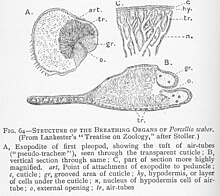This is an old revision of this page, as edited by Ehrenkater (talk | contribs) at 08:48, 10 October 2024 (→top: Copy edit). The present address (URL) is a permanent link to this revision, which may differ significantly from the current revision.
Revision as of 08:48, 10 October 2024 by Ehrenkater (talk | contribs) (→top: Copy edit)(diff) ← Previous revision | Latest revision (diff) | Newer revision → (diff)

en endopodite
ep epimeron
ex exopodite
lg pleopodal lung
pp pleopod
pr protopodite
pt pleotelson
ur uropod

Pleopodal lungs are an anatomical feature of terrestrial isopods and a component of their respiratory system. They are ancestrally derived from pleopodal gills, and they facilitate gas exchange on land. They perform a function similar to spiracles in insects.
Pleopodal lungs are identifiable on woodlice as white patches on the lower five segments (the pleon) on the ventral side (underside). The number of pleopodal lungs varies by species: they may have up to five pairs, or only two pairs as in Porcellio laevis; a minority of species lack pleopodal lungs entirely.
References
- ^ "Woodlice: 'pleopodal lungs'". British Myriapod and Isopod Group. Retrieved 2020-04-24.
- Unwin, Earnest Ewart (1931). "On the structure of the respiratory organs of the terrestrial Isopoda". Papers and Proceedings of the Royal Society of Tasmania: 37–104. ISSN 0080-4703.
This Arthropod anatomy-related article is a stub. You can help Misplaced Pages by expanding it. |